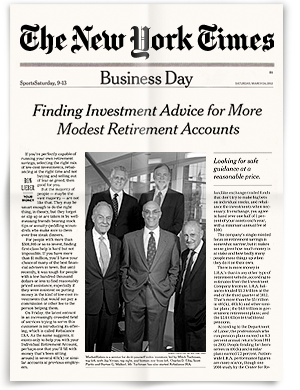Rebalancing Your Portfolio Takes Discipline; a Nudge Can Help

Why is rebalancing an integral part of retirement investing? In this piece for Chicago Tribune, Terry Savage showcases a main tenet of Rebalance‘s investment approach, and explains the many benefits rebalancing provides to your portfolio.
Buying and holding a diversified portfolio of American stocks — such as the S&P 500 stock index — has been a winning strategy over the long run, beating most managed mutual funds and investment adviser recommendations. But what happens if it’s too successful?
That’s actually a problem you might have today. As the market reaches all-time highs again and again, the value of your stocks might have started to overwhelm your appropriate asset allocation — especially if you’re nearing retirement and soon will need to start making required annual withdrawals.
The S&P 500 index has made 204 all-time high closes since 2012, according to Daniel P. Weiner, editor of the Independent Adviser for Vanguard Investors newsletter. If you sold at the highs, you would have regretted each of those sales.
And what if you didn’t sell? Weiner’s report shows that if you had started with a 60/40 allocation to stocks and bonds at the market lows of March 2009, today the stock portion of your portfolio would have grown to an 80/20 stock allocation — perhaps far more equity exposure than is appropriate at your stage in life, eight years later.
But, then, when do you sell? Do you have the discipline to prune back stock market holdings as the market rises? On the other hand, do you want to wait until the market rebalances for you — in a sickening slide that brings the value of your stock holdings back down to a lower level?
Here are three tips for the discipline of rebalancing inside a tax-deferred account:
• Set an appropriate allocation percentage to stocks, bonds, international, real estate and even a small percentage to gold, energy and/or precious metals. Review that percentage only every three years.
• Rebalance back to your target allocation no more than twice a year, on pre-set dates, preferably not around year end when markets become distorted.
That sounds so simple, but it may be difficult to do when markets are volatile. Knowing your own weaknesses, you might opt to have someone do it for you.
Consider the automatic service offered at www.Rebalance-IRA.com, a registered investment advisory company. It offers individualized financial planning to create personalized asset allocation advice for IRA investments. Clients’ IRA funds are invested into one of the company’s six diversified portfolios, created by a group of market technicians and economists. The portfolios are invested only in Exchange Traded Funds (ETFs) in a variety of asset classes. The portfolios range from conservative to aggressive.
Each portfolio is automatically rebalanced back to the targeted allocation twice a year — in late April and mid-November. So if one segment of the stock market has risen, some assets in each portfolio are sold, while others are purchased.
The overall management fee for this advice is 0.5 percent — or 50 basis points, plus a charge of $35 per account each time the account is re-balanced (twice a year). And, of course, the underlying ETFs have their own small costs, averaging 17 basis points per year. The minimum account size is $100,000. It’s a relatively small fee for both diversification advice and discipline.
Of course, you could use the services of a broker or investment adviser to guide you to rebalancing back to your original (or revised) targets. But be sure to consider transaction costs as you buy or sell stocks or funds.
If you use the services of mutual fund companies like Fidelity or Vanguard, you can get free initial asset allocation advice for your IRA rollover. And if you sign up for a “Fidelity Go” account at Fidelity (minimum $5,000 investment), the company will rebalance your account at the discretion of an investment manager, informing you online after the trades have been made. The fee is 35 basis points all in, including the underlying fund costs.
No matter what route you take, if you haven’t done any rebalancing since the start of the current bull market, this is definitely the time to take a second look at your growing exposure to stocks. And that’s the Savage Truth.






